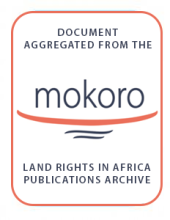/ library resources
Showing items 1 through 9 of 50.Management of environmental externalities of agricultural production has become a necessity to attain sustainable resource use and efficient use of resources.
Dryland salinisation is a non-point and intertemporal stock externality which requires a dynamic modelling approach to study its long-term management.
Examines international evidence on the relationship between asset ownership and growth and the impact of redistributive land reform, plus evidence of the impact of land reform in Zimbabwe. Asks why it appears that resettled farmers are among the poorest in the population.
Gives views of the Alliance on co-ownership in current controversy with the Vice-President. Mentions studies carried out by the Alliance and the Ministry of Lands. Concerned about government’s marginalisation of issues concerning women and poverty.
Brief statement containing purpose of the workshop, assessment of need, mission and objectives, thematic approach and activities, structure, membership and management, immediate next steps, forward planning, the question of a corporate name (LANDNET AFRICA).
Covers workshop organization, the opening session, reports by consultants from East, West and Southern Africa, presentations by resource persons; group sessions, mission statement, closing remarks.
Introduction to a new book, At the Crossroads: Land and Agrarian Reform in South Africa into the 21st Century, based on a PLAAS/NLC conference of July 1999.
Examines the current crisis in Zimbabwe, the land question in Zimbabwe and South Africa, the two land redistribution policies compared, poverty and the rule of law, populist policies and land invasions.
A response to the Minister’s Briefing (below). Asks who is land redistribution really serving. Challenges false dichotomy between commercial and subsistence agriculture. Need for government programmes to be open to close scrutiny by civil society.
Pagination
Land Library Search
Through our robust search engine, you can search for any item of the over 73,000 highly curated resources in the Land Library.
If you would like to find an overview of what is possible, feel free to peruse the Search Guide.


